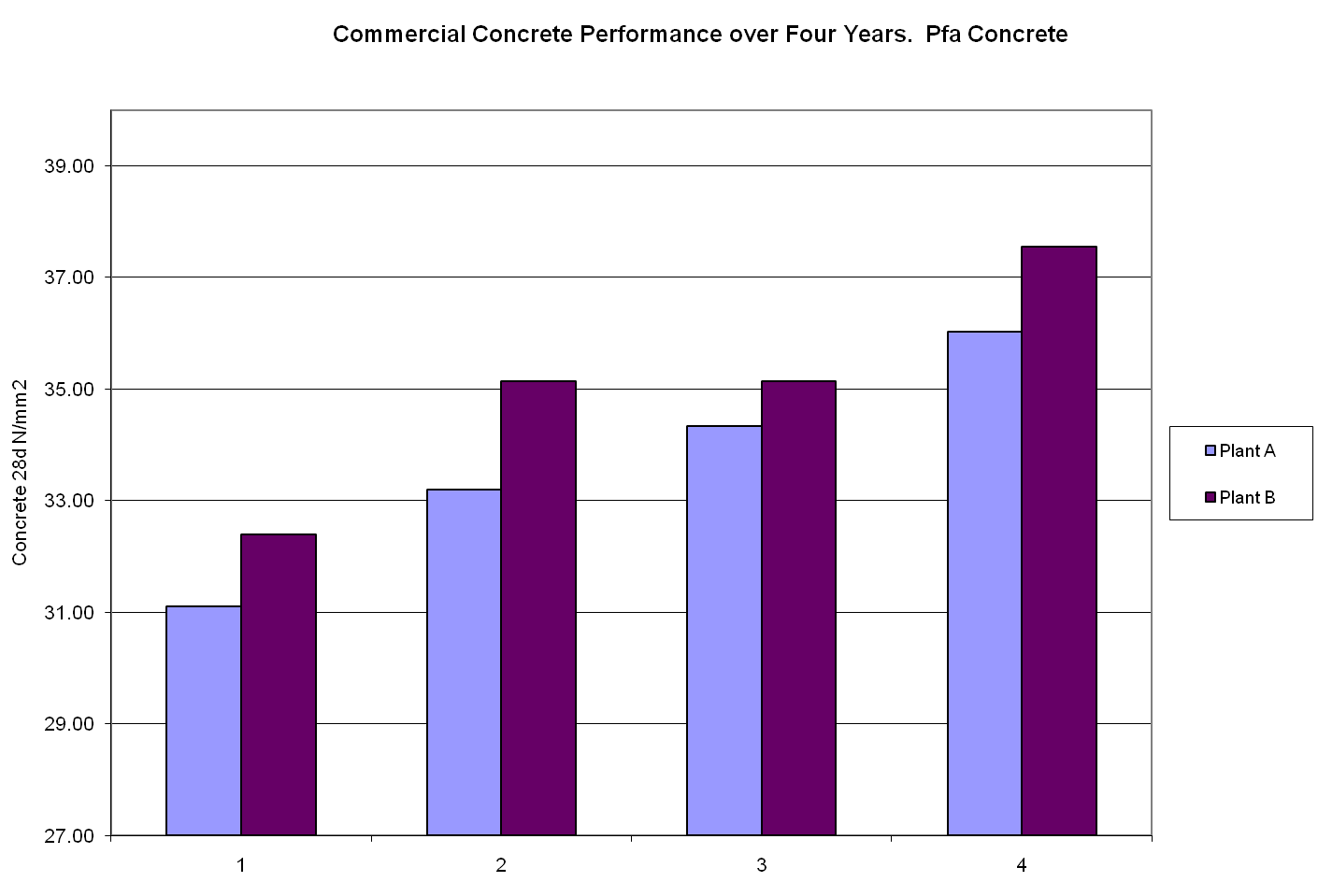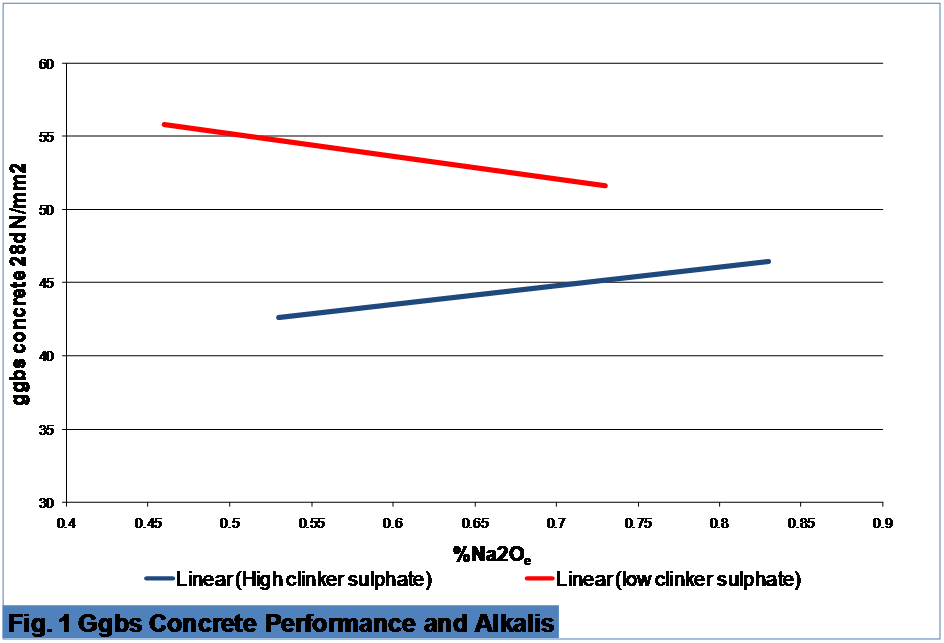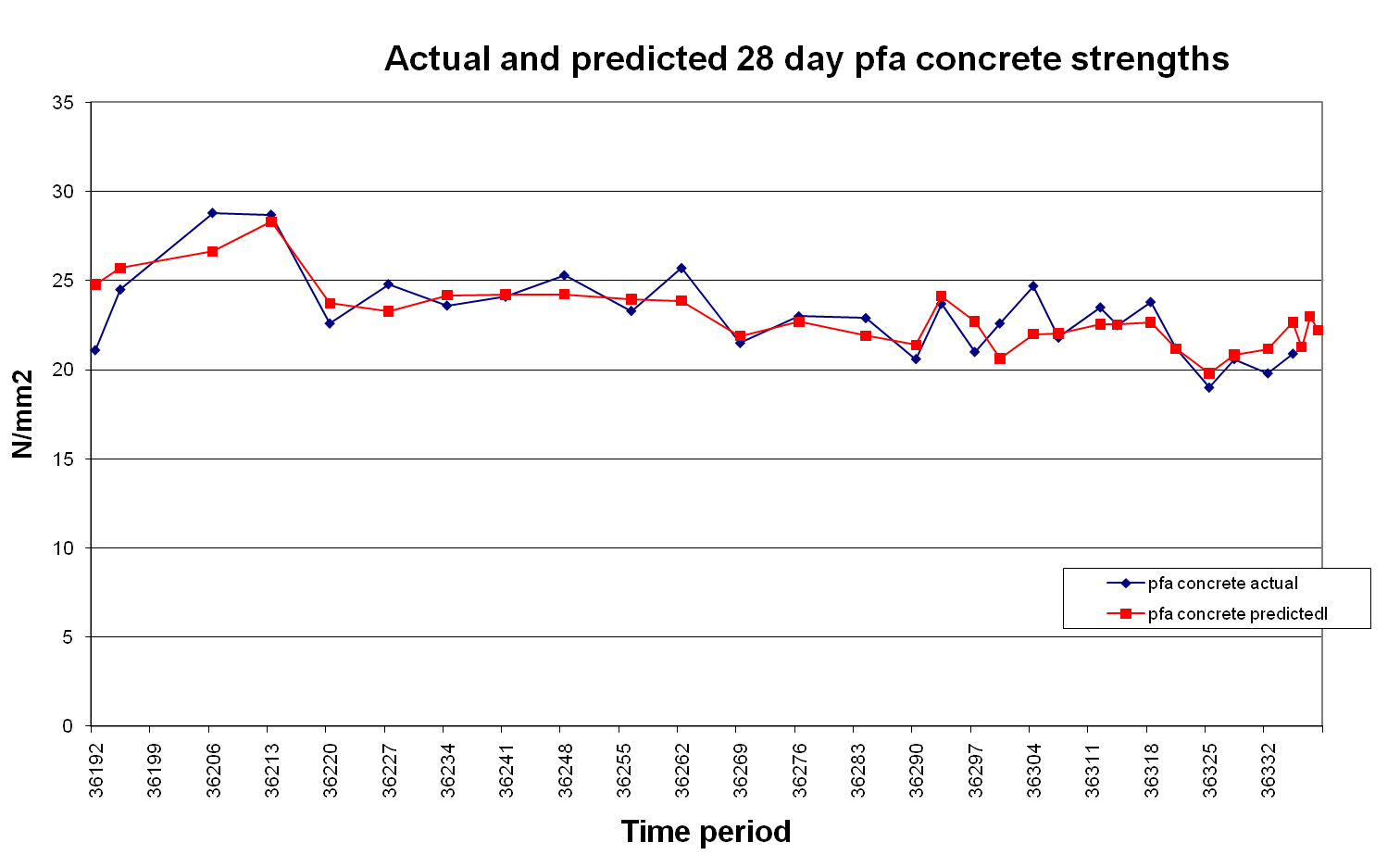Arthur M Harrisson Ltd
Quality
Contact
Home Background Raw Materials Limestone Chalk Cement Chemistry Secondary raw Materials Clinker Microscopy Solutions
What do I mean by "Quality"?
There
are as many definitions of good quality cement as there are uses for cement.
Early strength, late strength, durability, water reduction
properties, colour.
By
applying simple data analysis techniques combined with years of experience of the materials and of the process I have
faciliated improvement to the quality of cement for the customers at each plant
with which I have
been associated. The same approach applies to whichever aspect of
quality is of interest to a plant. The chart to the right shows
the change over
four years at two UK cement plants which had been poor performers with
fly ash in concrete. Through all this period the average mortar
28 day strength remained close to 60 N/mm2 as required to maintain the cements' designations.
and of the process I have
faciliated improvement to the quality of cement for the customers at each plant
with which I have
been associated. The same approach applies to whichever aspect of
quality is of interest to a plant. The chart to the right shows
the change over
four years at two UK cement plants which had been poor performers with
fly ash in concrete. Through all this period the average mortar
28 day strength remained close to 60 N/mm2 as required to maintain the cements' designations.
While
I am familiar with the cement standards used in many countries, I am
not an expert in the fine detail of this and am not a Quality
Assurance specialist, rather I am very experienced in
understanding what the customer requires and providing the best product
for the desired purpose.
What can be done?
I offer an analysis of plant materials, data and products to help to achieve improvements in the market.
Although a visit to site is sometimes helpful, the analysis is
laboratory based and thus avoids the necessity for expensive travel and
accommodation while being applicable anywhere in the World.
It
is unlikely to be possible to
produce a different cement to suit each customer and it is therefore
generally necessary to optimise the properties of the cement for the
plant's main customer base while also making what improvements are possible in
other areas without adversely affecting the primary targets.
 Prediction of Quality
Prediction of Quality
Quality
prediction is frequently available within cement companies based on methods of variable robustness. Customers
may be aware of the predictions, salespeople use them or not depending
on the
perceived value of the figures.
The cement makers are often not
aware of the predictions, nor of what aspects of the product most
influence the particular properties required by each customer.
Quality is one thing to the cement plant - usually conformity to
the local standards. To a precast manufacturer it will usually be
the early strength in concrete (not necessarily in mortar prisms) which controls the
company's profit levels.
To ready mix concrete makers the
quality of the cement is overwhelmingly dependent on the water demand
of the freshly mixed concrete. If fly ash is being used the perception of quality will not be the same as for plain Portland cement concrete. If blastfurnace slag is being used it will be different again.
being used the perception of quality will not be the same as for plain Portland cement concrete. If blastfurnace slag is being used it will be different again.
Figure
1 shows that relationships between some properties and quality are not
simple. If the alkali level of a cement increases it will be
advantageous in ready mix concrete if the clinker sulphate is high but disadvantageous if the
clinker sulphate is low. This is because alkali will combine
with sulphate in the clinker to provide a very soluble source of
sulphate to retard gypsum reaction and improve workability thus
reducing water demand but, if there is insufficient sulphate present,
the alkali will become incorporated in the C3A, affecting its reactivity with unpredictable effects.
It
is always useful for customers if the cement provider can give a
prediction of cement quality immediately after production instead of
waiting 7 or 28 days to see how the test results turn out. It is
also invaluable to the cement maker to understand why the cement is not
performing as expected. There are
generally about 5 or 6 factors which control how a cement will behave
in practice but the effects of varying these factors will not always be
the same and the history of an individual plant must be analysed to
obtain the most accurate predictions for a given parameter. The
factors may include fineness, C3S content, alkali level and SO3
content, free lime and loss on ignition (LOI). The LOI is largely
determined in most cements by the quantity of limestone filler added at
the milling stage, the loss at high temperature being due to
calcination of CaCO3. It can also be a result of
hydration of the clinker before milling, perhaps as a result of being
stored outside in a damp climate. While the limestone can have a
beneficial effect in assisting water demand in concrete, the effect of hydration
of cement crystals is generally negative and if this is a likely event
it is therefore helpful if the two causes of loss can be separated.
Having
identified the primary causes of change in performance those which
cause the most variability are tabulated, together with the performance
parameter being studied, and a multiple linear regression analysis is
performed. This produces an equation reflecting the influence of
each variable on the performance. The example below is for 28 day
strength in mortar prisms
28d strength = 64-(0.4*45µ)+(0.2*C3S)-(13*Na2Oe)-(2*LOI)
So increasing the 45µ residue decreases strength, increasing C3S increases strength and increasing alkali or loss will give a decrease in 28 day mortar strength.
While
for 28 day mortar strength at a fixed water content these figures are
fairly typical, of far more significance in ready mix concrete is the
quantity of water which is required to obtain a specified workability.
A major influence is the
rapidity with which sulphate can be put into solution with in mixing
water and thus retard the flash set of C3A. The rapidity is in turn affected by how much sulphate is present as
alkali sulphate in the clinker and how much dehydration of gypsum has
taken place. A second influence is the particle size distribution of the cement
grains. A high efficiency separator on a cement mill produces a
very narrow particle size distribution which is not conducive to
flowability of the cement or workability in concrete. A minor
addition of limestone or other fine filler (up to 5%) fills in the
spaces between the evenly sized cement
grains aiding fluidity and also taking up the space which would
otherwise be occupied by water. The effects of alkali and filler
(LOI) are therefore likely to be different on the strength of concrete
made to a
given workability than on that of a mortar made to a constant water
content.
A high efficiency separator on a cement mill produces a
very narrow particle size distribution which is not conducive to
flowability of the cement or workability in concrete. A minor
addition of limestone or other fine filler (up to 5%) fills in the
spaces between the evenly sized cement
grains aiding fluidity and also taking up the space which would
otherwise be occupied by water. The effects of alkali and filler
(LOI) are therefore likely to be different on the strength of concrete
made to a
given workability than on that of a mortar made to a constant water
content.
As
well as providing some indication of future performance of a cement,
based on the various parameters measured, the true value is in
prioritising the factors which adversely affect the quality. A
value can be put on the benefits of improving each aspect of the cement
production so that sound financial case for improvement can be made.
Arthur Harrisson 2011 and of the process I have
faciliated improvement to the quality of cement for the customers at each plant
with which I have
been associated. The same approach applies to whichever aspect of
quality is of interest to a plant. The chart to the right shows
the change over
four years at two UK cement plants which had been poor performers with
fly ash in concrete. Through all this period the average mortar
28 day strength remained close to 60 N/mm2 as required to maintain the cements' designations.
and of the process I have
faciliated improvement to the quality of cement for the customers at each plant
with which I have
been associated. The same approach applies to whichever aspect of
quality is of interest to a plant. The chart to the right shows
the change over
four years at two UK cement plants which had been poor performers with
fly ash in concrete. Through all this period the average mortar
28 day strength remained close to 60 N/mm2 as required to maintain the cements' designations.  Prediction of Quality
Prediction of Quality being used the perception of quality will not be the same as for plain Portland cement concrete. If blastfurnace slag is being used it will be different again.
being used the perception of quality will not be the same as for plain Portland cement concrete. If blastfurnace slag is being used it will be different again. A high efficiency separator on a cement mill produces a
very narrow particle size distribution which is not conducive to
flowability of the cement or workability in concrete. A minor
addition of limestone or other fine filler (up to 5%) fills in the
spaces between the evenly sized cement
grains aiding fluidity and also taking up the space which would
otherwise be occupied by water. The effects of alkali and filler
(LOI) are therefore likely to be different on the strength of concrete
made to a
given workability than on that of a mortar made to a constant water
content.
A high efficiency separator on a cement mill produces a
very narrow particle size distribution which is not conducive to
flowability of the cement or workability in concrete. A minor
addition of limestone or other fine filler (up to 5%) fills in the
spaces between the evenly sized cement
grains aiding fluidity and also taking up the space which would
otherwise be occupied by water. The effects of alkali and filler
(LOI) are therefore likely to be different on the strength of concrete
made to a
given workability than on that of a mortar made to a constant water
content.